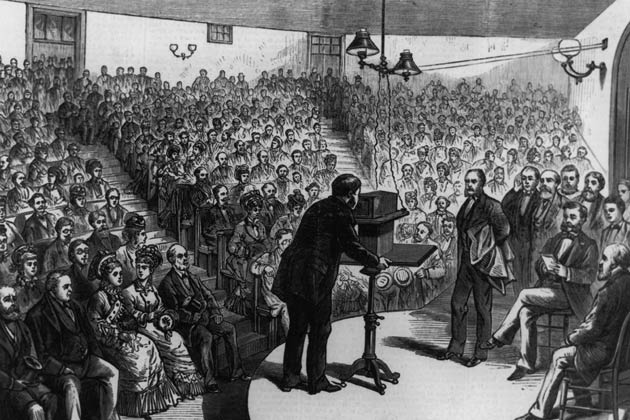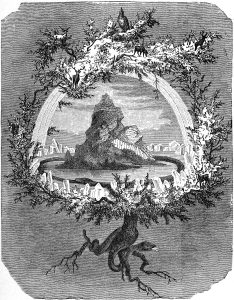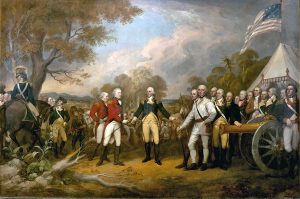Lyceums combined education and oratory, two passions of the mid-nineteenth century, in the 1830’s to create a movement that was both popular and educational. The name lyceum comes from the ancient building in Greece where Aristotle taught. However, in the United States, lyceum did not describe a building, but a revolutionary phenomenon. Josiah Holbrook, the father of the lyceum movement, created this ideology to bring knowledge to adults.1
Holbrook himself gave a series of lectures to an audience of farmers and mechanics in Millbury, Massachusetts, in 1826. He taught instructions in science, politics, art, and literature. From this small project, the lyceum movement quickly spread throughout Massachusetts, New England, and other parts of America.2

Lyceum organizers used public libraries, vacant schools, and other such spaces for classroom locations. They recruited leading scholars, politicians, and orators of their time to provide entertainment and instructions to adult audiences. Topics such as politics, science, art, literature, history, and philosophy were immensely popular.3
The lyceum in Massachusetts sponsored diverse lectures in 1838 that included “Causes of the American Revolution,” “The Sun,” “The Legal Rights of Women,” and “The Satanic School of Literature and Reform.” The lyceum offered hundred of speeches and featured interesting lecturers such as geologist Benjamin Silliman from Lowell Institute in Boston, naturalist Louis Agassiz, Russian traveler Geroger Kennan, and writer-physician Oliver Wendell Holmes. In 1837 and 1838, approximately thirteen-thousand people attended the Lowell Lectures in Massachusetts.4

The lyceums opened their lectures to everyone. There were only two rules set in place for attending the lectures; first, attire was to be appropriate, and second, no one was allowed to leave the hall during a lecture. While lyceums served as entertainment for adult audiences, their main purpose was to educate.
As the United States became increasingly preoccupied with diverse ideas and battles over slavery, the lyceums served as forums for discussion of public controversies. For instance, in Springfield, Illinois, in 1838, Abraham Lincoln gave a series of speeches to denounce the lynching of slaves in Mississippi and an attack on a free black man in St. Louis. He lectured in lyceums on how the reverence for the laws should be the political religion of the nation.5
In the years following, prominent abolitionists such as William Lloyd Garrison, Wendell Philips, Frederick Douglass and others became the most popular orators at lyceums. Douglass traveled widely to speak at lyceums. He was featured in lyceums in Central Ohio, the Islands of Nantucket, Massachusetts, and in England. Douglass became one of the most widely admired public figures of his time through his mesmerizing speeches at the lyceums.6

Lyceums were places for men and women to educate and improve themselves by listening to knowledgeable speakers who covered topics in their field. The lectures both reflected and helped strengthen the growing interest in education in the 1800s in America. Lyceums definitely helped the expansion and improvement of the public school system in America. Moreover, they marked the beginning of many decades of efforts to extend the benefits of education to adults. They formed the lecture system of education, which is the staple of university education even today. At the heart, lyceums helped to spread explosive ideas about slavery, freedom, and union.7
- Vyacheslav Khrapak, Reflections on the American Lyceum: The Legacy of Josiah Holbrook and the Transcendental Sessions (Universiy of Oklahoma, 2014), 48. ↵
- Alan Brinkley, American History: Connecting with the Past Volume 2, 15 edition (New York: McGraw-Hill Education, 2014), 138. ↵
- Brinkley, American History: Connecting with the Past, 138. ↵
- Khrapak, Reflections on the American Lyceum: The Legacy of Josiah Holbrook and the Transcendental Sessions, 52. ↵
- Angela Ray, “Learning leadership: Lincoln at the lyceum,” Rhetoric & Public Affairs 13, (2002): 365. ↵
- Angela Ray, “Frederick Douglass on the Lyceum Circuit: Social Assimilation,” Rhetoric and Public Affairs 5.4 (2002): 625. ↵
- Brinkley, American History: Connecting with the Past, 138. ↵



31 comments
Joshua Tinajero
Its great to hear about our predecessors attempts in creating change through educating the people with the help of entertainment. I never knew that Abraham Lincoln once taught a lecture about abolishing slavery at the Lyceum, good informative article.
Oscar Sepulveda
These people were awesome and they helped so many that could not get an education. They made a big difference for many around the times to show people about the things that matter a bit in life. Great article. Well written and easy to understand.
Mariana Sandoval
It’s awesome that people were interested in educating themselves in their free time about varying topics and that people were willing to give people some insight into other aspects that they wouldn’t have been taught in a regular educational setting. I thought your article was really nice at introducing a topic that most people probably have not heard of and it sheds light on an inspiring piece of American history.
Andres Palacios
I didn’t know anything about Lyceums before reading the article so I’m glad that I got to learn about a new topic today. Lyceums are a great and effective way of educating the population, I think that farmers and industrial workers benefited the most from it since most didn’t have a proper or formal education, this was a fun way to get educated.
Desmond Bonsignore
I had never heard of Lyceums before this article and I can say now that I am very informed on the topic! Very detailed and well written article. The fact that this movement helped the formation of public schools in America is astounding.
Jeanette Wimberly
First off, great article! I’ve never heard of lyceums before, so it was a very interesting read. It’s wonderful to learn that thousands of people attended these lectures and speeches in order to further their education. What was surprising was how they would not let people leave during a lecture. Very informative, keep it up!
George Manzanares
Great job on illustrating such an important time in history. More often than not, modern society tends to forget how much of a privilege education is to all. I personally did not know that lyceums even existed. However, as you mentioned such educational presentations helped rid of ignorance during that time period. Furthermore, it aided in expanding education in the country. Well done!
Maranda Avina
Well written and very interesting. I have had a brief introduction to Lyceums but it was interesting to see the greater purpose they served. Spreading education and informing the people of ideas and issues going on in that time is really amazing. Great job!
Victoria Sanchez
I briefly learned about lyceums in high school, but the lesson did not go into as much detail as you did in your article! The lesson, in fact, was so minimal that until reading your article I had forgotten about lyceums altogether, so it was a very refreshing reading for me! I had no idea that Lincoln presented at one of the Lyceums; that in particular was very interesting to me seeing as his lyceum speeches that spoke against the mistreatment of African Americans came only nine years before he delivered his Spot Resolutions to Congress in opposition of the Mexican-American war. It was incredible to hear that Lincoln’s defense of minorities began so early in his career. Overall, you presented very good information about the 19th century lyceums! Well done, thank you for sharing!
Kassandra Guillen
Interesting and well written! Throughout the years in history classes I have heard of this revolutionary phenomenon, but have never been given so much information on the backstory and the impact these gatherings made during this time in history. It is interesting to learn the origin in which the lecture system of education that universities have adopted developed. Thank you for teaching me something new!